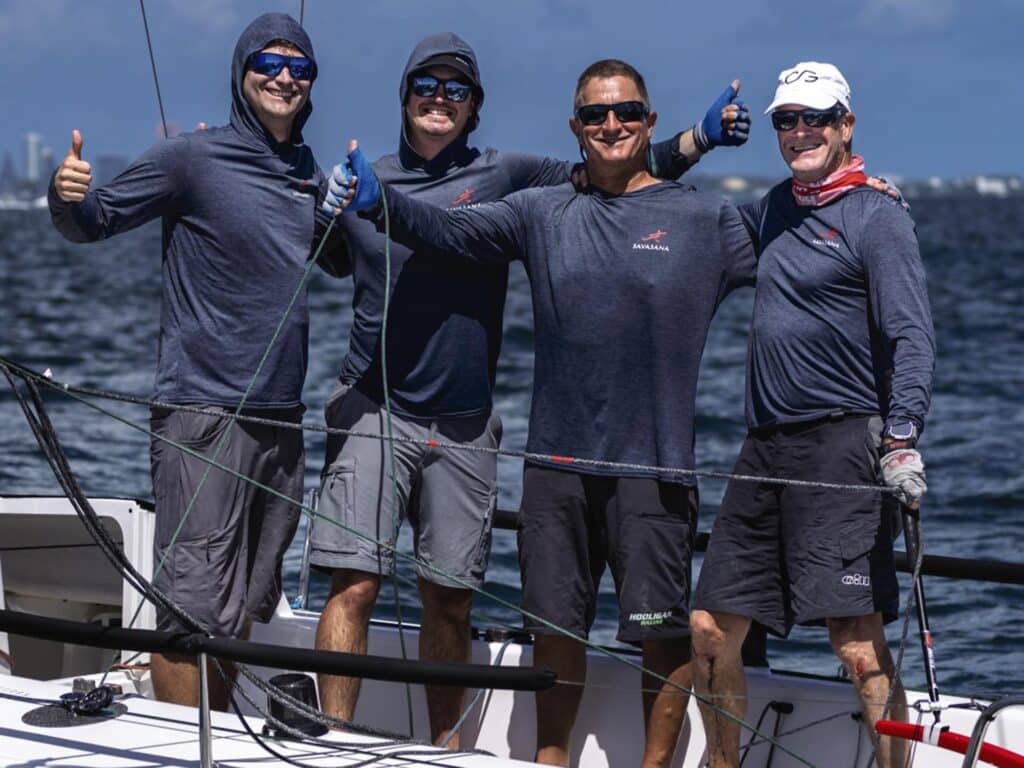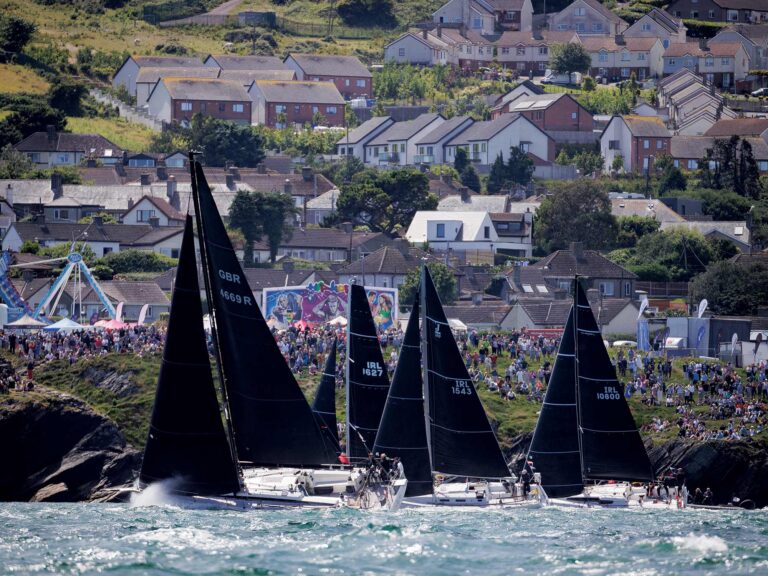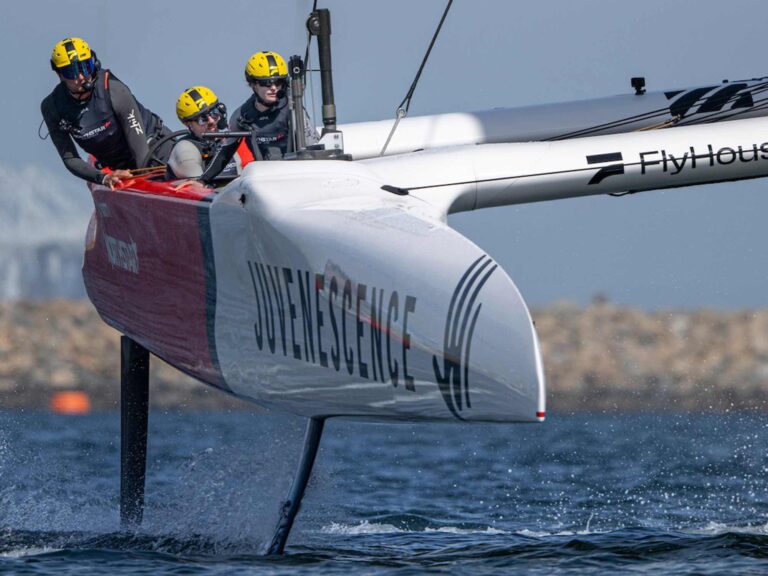
The most recognizable spinnaker in the US J/70 fleet is arguably the white one with a stylized red stick figure. And it is immediately recognizable because Brian Keane’s Savasana has been a fixture of the class since 2012, usually near the front of the fleet and found wherever J/70s gather in numbers. Keane and his teammates have won plenty of J/70 regattas over the years, but never a world championship. Close, yes, but never No 1.
However, his current cast of teammates—Thomas Barrows, Ron Weed and Conner Harding—have their collective minds set on the impending Worlds in St. Petersburg, Florida, in November. There’s no reason to doubt this could be their year to win the big one, especially considering they ran the table on the Miami J/70 winter regatta circuit with three big wins and then followed up with another at Charleston Race Week.
You might think this peak in Keane’s long sailing career, which includes Junior National Championships, All-American honors and the Hinman Trophy, and has spanned eras in the J/105 and J/80 classes, is the result of some game-changing sail development or magic bullet. But you’d be wrong. The difference is Keane’s present battle with cancer.
“Fewer things bring about clarity, focus and purpose than knowing you have been diagnosed,” Keane says when we speak by phone in April after winning the J/70 Midwinters. “I can say for sure that has helped me this year because I want to win. It’s a focus. Millions of people have cancer, but it’s real, and I’m confident in a full recovery. That purpose is important to me.”
That is certainly a far bigger challenge than battling at the top of a pro-stacked one-design fleet.
“A lot of people may feel the J/70 class is overly pro-ed up, and I can understand that. But for myself, I want to go against the best of the best, and I love the fact that the class is not being dumbed down. It’s still exciting for me, and many of the newer teams to the fleet to go against some of the people they’ve been reading about or have heard about.”
What’s on the road to the Worlds for Savasana?
So far this year, we’ve done two Davis Island events, then the Helly Hansen Sailing World Regatta in St. Petersburg, the Bacardi Invitational in Miami, the Midwinters and Charleston. We’ll do [HHSWRS] in Annapolis and Marblehead, North Americans in Chicago, and then we’ll be spending some time in St. Pete in October before the Worlds.
Given that most well-attended events like the winter regattas are 50- to 60-boat affairs, what do you find are keys to success on these crowded racecourses?
First is the team mentality. To have any chance of winning, every team member must understand what their job is and do it to the best of their ability. At the same time, each of us needs to understand what every other person’s job is and what the interdependency is. That interaction is super important to our team and our time in the boat. At any point in the race, for example, I know what Thomas or Ron is doing, and that simplifies the language on the boat. We are always together during events. We learn together, we eat together, watch movies at night and talk about sailing all the time.
The second thing is communication, which does sound trite, but there are two categories of this: communicating what’s happening outside the boat and what’s happening inside the boat. This is all routine for us at this point. For the outside stuff, for example, before starting each race, I’ll start off the questions: What do we see? What’s our opinion? What do we see on the water? How does it compare to the forecast? What did we learn in the last race? What side of the line and why? During the race, communication shifts to our speed and height relative to the other boats around us. In the big fleets, I’m not looking around, and a lot of it is how quickly you can find a free lane after the start. So, it’s so important to have the team looking around and providing real-time feedback on the wind, current, boat performance and tactical situation.
Inside-the-boat communications is about making sure we’re set up for the given conditions. Before the race, we ask about the rig, the backstay, the jib tracks, making sure we’re in the right gear off the line. The gear you set up in for the start may be a different gear than you’re in 10 minutes later, so it’s imperative you always start in the right gear.
During the course of the race, we are a quiet boat; just talking about how the boat feels and taking a lot of input. I’ve been on a lot of boats where it seems the only person who has a valid opinion is the tactician, but we have four good sailors on the boat, so it’s important to hear how everyone feels and what they think is important. I think we do that as well as anybody.
The next category is adjustments, and I think we’re at a new level this year. That’s making a difference. Especially in the challenging conditions of Miami, with the waves and the wind, it is so essential to be always adjusting. The J/70 has so many tools, but the tools are useless unless you use them. With adjustments, we think of it from front to back: jib halyard, jib track, the ratio between the primary (sheet) and the inhauler. The traveler, backstay, vang and cunningham—in that order. Whatever we do with the headsail drives how we set up the main and how I drive the boat. Even a windspeed change of 2 knots or a modest change in wave state will require one or several changes of these tools.
We keep getting better at this and knowing what each of us will do and knowing what those adjustments are. The key to that is we compile comprehensive notes after each practice day and every race day, and it all goes into a repository. That becomes our baseline, and it allows us to be at that point where we can sail by the numbers. For example, if we are high and slow, the reaction is, “OK, let’s do X, Y and Z, and if we’re low and fast, let’s do A, B and C,” but we already know what the playbook is. Any team that’s serious has to have this database of notes so things become intuitive.
We also have numbers all over our boat. Let’s say we’re sailing in a regatta using the J/9 jib. We know how it should be set up in terms of the jib track; then we start focusing on the ratio between the primary and inhaul sheets, so these go into the notes as numbers. For example: jib track at 6, primary at 3.5 and weather sheet at 8. During the race, we’re talking numbers, and if someone is feeling something, we might say, “Let’s go primary to 2. 5 and weather to whatever.” It’s knowing what the numbers are. A lot of teams just go into the boat and trim by eye or feel. We go to settings. It makes our life easier.
I imagine that makes things a lot easier for you to strictly focus on driving.
It’s been a huge change for me. I grew up as a singlehanded sailor, and in college sailing, the skipper does everything, and I don’t do that. I focus on driving, but I have the base of knowledge, and that’s why when everyone in the boat is talking about what’s going on and we’re problem-solving, I may chirp in with an observation. The goal is to get to the point where everything is happening naturally. For example, as we’re approaching a wave set, Conner is easing the jib halyard, and Thomas has already eased the backstay. We may adjust the jib halyard 20 times in a given windward leg. It’s very dynamic, and that’s not how we were sailing three years ago.
Do you play your own mainsheet?
I used to do it, but I have not for the last five years or so. It took a while to get used to, but you eventually realize you have two people to play three lines, and given how dynamic we are, I bet I am by far the most active person in the fleet when it comes to the traveler. It’s moving nonstop. I will drop the traveler an inch or two, and our level of heel does not change. That leads to more direct efficiency on the keel and rudder.
Take us through how you sail through puffs on the J/70.
Conner’s calling puffs; their strength and direction, and whether it’s a lifting or heading puff. The traveler is always uncleated and in my hand, and what we try to do is be dynamic with steering. Thomas is trimming in the backstay just as the puff is coming on with one hand, and his other hand is on the mainsheet, so he and I are playing all three at the same time. One of the effective things of a traveler burp is you can burp it out with the initial puff and almost within a second start trimming it back in; the heel-angle change is imperceptible. If we do that right, we’re going to gain half a boatlength with every puff from boats that don’t.
How about the jib adjustments?
If we are coming into either a big puff or chop, the weather sheet comes off, which gives me a bigger groove. The halyard is being played with every up and down change in velocity or any wave-state change that’s going to affect our speed. Flat spots are just as important as puffs and waves; if we approach the flat spot with speed, we can go with a little extra trim on the main and banjo the weather sheet for about 15 seconds to be able to feather up and gain a bit of height in that one flat spot.
Confident breeze calling is important to this style of dynamic sailing.
Yes. One of my pet peeves is when people become talking heads, and 80 percent of what they’re saying I feel no difference in my tiller or face. In that sense, sometimes less is more because if you are saying something, it has to be important. Along that note, whenever I have a substitution for an event, I remind everyone that we will all make mistakes, so no barking. Just carry on and do our job.
Share some thoughts on starting in this class, especially with everyone using GPS starting devices these days.
We can continue to get better here. In general, what works for us is to set up around our spot early, but setting up early comes with its trade-offs. You have to have the skills to defend against port-tack poachers and really be able to defend your space—doing double tacks and basically doing what you can to push away boats on both sides so you leave yourself enough runway so that when it’s go-time, you can go faster than the boats around you. If you’re late to accelerate because you are too close to the line, boats around you that started two lengths before will own you. For me, the big thing is if we don’t have a lane off the start, I will happily take as many sterns as I have to in order to get out and get a lane. We have confidence in our speed, so at that point in time, say 30 seconds after the start, you’re still within five lengths of the leading boat, and that’s not so bad. So, we’ll give away a few lengths by ducking to get a lane, and sometimes finding that lane may take two or three tacks. But if you have a leg that is 1.5 miles, it’s worth it. Plus, in big fleets, there is that phenomenon where the wind is coming down the course and the entire wind mass rises above the wall of masts and sails. It’s good to get away from that wall.
Winging has become a powerful tactical tool in the J/70. Your thoughts?
It’s been around for a long time, but right now some sailmakers, like Doyle, have a kite that’s made to be a better winger. It’s critically important, but you have to do it at the right time. You have to be going 5 knots before you’re even thinking about doing it. Secondly, if you’re rounding near the front of your fleet, it’s dangerous to wing too early because the wind block from the cone can be deadly. You can make good gains by letting the cone thin out a bit, do a full jibe, go for a minute, and then pop the wing. At that point, you are one of the first to go over, and you are far enough out to get the clear air and then able to go straight to the mark. But you have to earn the opportunity; you have to fight for the spot to make it happen, then wait for a breeze and then pop it.









